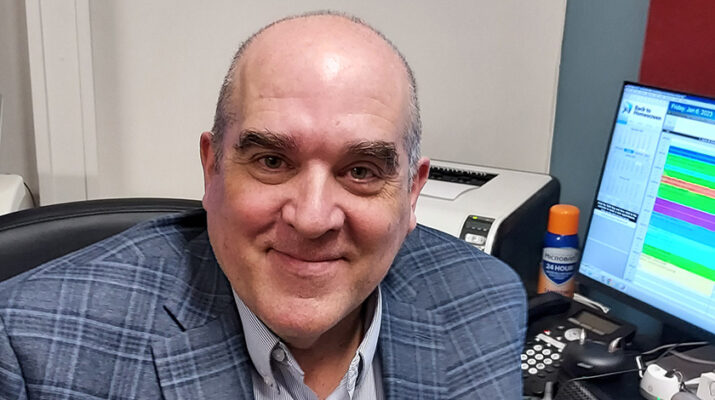By David Podos
‘Many of the people we serve are getting younger and younger. We see people who are in their early 40s and 50s.’
– Jim Bremer, owner of Bremer Hearing and Audiology
Audiologist Jim Bremer is owner of Bremer Hearing and Audiology in Mohawk Valley.
His parents started the business in the early 1950s. His dad became a hearing aid dispenser and opened his first office in 1956 in downtown Utica. He also opened an office in Rome and eventually expanded to Auburn, Oswego, Herkimer and Syracuse.
“My dad retired in the mid-1990s and I bought the business from him. In 2007 I sold most of the offices to a large national audiology company, worked for them for a while, then decided to re-open under my family name once again,” Bremer said. “Now we have two offices, one in New Hartford and the other in Rome.”
His business offers many services to the local community who suffer from hearing loss.
“We offer audiological services, testing, hearing aid services, assistive devices, as well as ear molds for musicians for ear protection,” he said.
Bremer said his practice sees all different kinds of people from all different ages with varying issues of hearing loss. He said he noticed that the age group is getting younger.
“Many of the people we serve are getting younger and younger. We see people who are in their early 40s and 50s. Of course, we still see a high number of patients who are much older,” he said. “For those who are younger, we can partially contribute their hearing loss to family history, where other members of the same family are experiencing hearing loss, so it is definitely tied in with family genetics. In fact, hearing issues run very strong in my own family. My brother for instance has a cochlear implant.”
Cochlear implants are offered by ent specialists to people who have severe hearing loss. It is an electronic devise that consists of two parts; one that sits behind the ear, the other part is surgically placed under the skin.
“Many of our patients have suffered from bad ear infections when they were children and that caused them to have hearing loss later in life. For our older patients they experience hearing loss as they continue to go through the aging process,” Bremer said.
Technology has certainly improved the quality of hearing aids, he added.
“The latest thing with hearing aids is over-the-counter hearing aids. People can go to the store buy a pair without a prescription and they are self-fitting. However, in my professional opinion they are like eye glass cheaters, the kind you buy in a store without seeing an eye doctor to get a proper exam and proper eye prescription. So, eventually, many patients will find themselves seeing audiologists like myself for a proper hearing aid that’s exclusive for their particular hearing loss,” Bremer explained.
While hearing aids overall are getting smaller and smaller, he said that’s not always the best choice.
“Very small hearing aids often times make it more difficult for correct fitting and in general, they also might not work as well as the over the ear hearing aids,” he said.
Bremer added that hearing aids are very different from ones 20 or 30 years ago.
“Since I started 30 years ago, hearing aids are completely different. The hearing aids today are not only able to process sound, but they know what direction that sound is coming from. As noise rises around you the hearing aids can amplify those sounds that are in front of you making it easier to hear when someone is talking so the background noise does not dominate, so the hearing aids are self-adjusting,” he said. As an audiologist Bremer can also pair your hearing aids to devices such as blue tooth or your Apple or Android cell phone. Bremer holds a master’s degree in audiology and in 2002 received his doctorate in audiology.
The National Institute of Health provides a snapshot of the percentage of people in the United States who are experiencing some level of hearing loss. It might be surprising to know that the extent of hearing loss among a wide range of demographics in this country is quite alarming.
According to the NIH records, about two to three out of every 1,000 children in the United States are born with a detectable level of hearing loss in one or both ears. Approximately 15% of American adults (37.5 million) 18 and older report some trouble hearing. One in eight people in the United States (13% or 30 million) 12 or older has hearing loss in both ears, based on standard hearing examinations. Age is the strongest predictor of hearing loss among adults aged 20-69, with the greatest amount of hearing loss in the 60 to 69 age group.
There are many conditions that can cause hearing loss, some of the more common ones are, earwax buildup, viral infections, ruptured eardrums, which are quite common according to NIH stats, [particularly] by injuring the ear (tympanic membrane perforation) from poking the ear with a cotton swab.
There are other issues as well that can cause hearing loss such as taking certain medications, (aspirin in large dosages, non steroidal anti-inflammatory drugs, and diuretics to treat high blood pressure and heart failure). Illnesses such as measles, mumps, and diabetes to name a few can also contribute to hearing loss.
An ear nose & throat doctor is trained to diagnosis hearing loss and what form of treatment would be best. These could include for example, surgery, medications and or hearing aids.
For many people with hearing loss, hearing aids are often life savers, providing an improvement in their overall hearing. Audiologists are professionals with years of college education enabling them to treat hearing disorders and recommend proper hearing aid devices.

